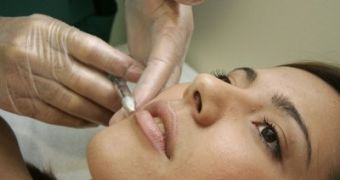Modern women are raging a no-expenses-barred war on wrinkles, and in true war-time fashion, pretty much everything is fair in the struggle to keep age at bay. In other words, any tip and trick from the anti-wrinkle book has been thoroughly examined and dealt with, from face masks to professional chemical treatments to cosmetic procedures such as permanent or temporary implants. Recent studies have shown that despite their growing popularity, the latter pose serious health risks for women, who often go through with the implant procedure without knowing that the substance injected into their lips, cheeks and forehead could cause severe allergic reactions later on.
Popularly known as "facial fillers", polyalkylimide implant gels are in fact a compound of gel and water injected into various areas of the face such as the forehead, the cheeks or the lower facial lines between the nose and the mouth in order to improve their appearance. A more popular (at the moment) option is the use of temporary fillers, which offer roughly the same results but for a shorter period of time. However, researchers warn that the permanent facial fillers could in fact turn out to be a veritable time bomb, as they could cause severe allergic reactions months after the implanting procedure was carried out.
A recent study focused on 25 patients who developed adverse reactions to the fillers over a year after undergoing the actual procedure. "According to the manufacturer's information, polyalkylimide structures show no change over time and do not move or migrate. [...] However, more recent evidence refutes these statements and so the complete safety of polyalkylimide implant gels can no longer be assured", warns Dr Jaume Alijotas-Reig, of Vall d'Hebron University Hospital and Autonomous University of Barcelona, Spain, in an interview with the Daily Mail.
The side effects developed by the patients included swelling, the appearance of lumps near the injection site, fever, dry eyes or mouth and arthritis symptoms. The report also warns that women who undergo repeated such treatments may manifest an added sensitivity to the use of more than one type of cosmetic filler, which would then lead to the appearance of serious side effects.
However, a representative of the British Association of Aesthetic Plastic Surgeons reveals that the results of this study are not exactly news to plastic surgeons, most of which are already aware of the potential side effects of permanent fillers. "They have a poor history of causing problems in facial tissue including red lumps that can only be removed surgically which leaves scarring. They may be used in some circumstances, but need to be injected deep beneath the skin's surface", stated plastic surgeon Nigel Mercer, president of the association. It is therefore extremely important that all the women who consider getting such treatments be aware of the situation and ask their plastic surgeon for all available information and consider all the risks before making a final decision.

 14 DAY TRIAL //
14 DAY TRIAL //